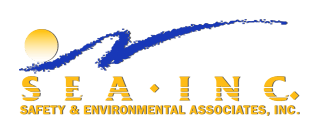ENVIRONMENTAL SAFETY TRAINING YOUR BUSINESS NEEDS

According to OSHA regulations, and depending on the industry you are in, there are a variety of special safety training programs your employees should receive. It is vital that your company provides all industry specific, legally mandated training to your employees or to those fulfilling certain roles. Training and courses like those provided by SEA, Inc. can keep your company regulation compliant, and your employees safe and better protected.
That being said, if your company or any team member will be working with, or might come in contact with hazardous materials, special safety and environmental training courses are a must. Without HAZMAT training, your business could be in violation of federal laws. Not only is this a dangerous situation for your staff, and possibly for your neighbors, and the environment, but without the training that regulatory organizations like OSHA, the EPA, and the DOT require, you could have fines and penalties levied against your firm. Generally speaking, if your business works with, produces, transports, or does anything with hazardous or potentially hazardous materials, your employees need to know how to avoid HAZMAT incidents. HAZMAT training gives your employees the necessary knowledge to adhere to HAZMAT guidelines keeping them safe, and protecting the environment. Training also includes instruction on how your staff should respond to a HAZMAT incident if one occurs; this includes showing them how to isolate the incident, and evacuate a dangerous area. Because of the wide variety of regulatory guidelines that are required for specific industries, there are also a variety of training courses available to your business. SEA, Inc. customizes training courses based on needs of the business in an industry, and the regulatory requirements. A one-size-fits-all approach doesn’t work for training when it comes to hazardous materials. Your team must be aware of situations that could actually be encountered, and they need to be well trained for real, potential situations.
These courses not only meet the expectations of regulatory bodies, keeping your business from getting into trouble by violating laws and your employees safe, but it also exceeds those expectations by keeping the community and environment safe if an incident should occur.
There are several HAZMAT, hazardous waste, and other courses you may need to provide to your employees. Courses like HAZWOPER, and Hazardous Waste Operations and Emergency Response, are comprehensive, and required by OSHA for many companies.
Beyond training, it is important to note that your employees may not be able to do it all. In some situations, outside help may be required for environmental management services for high hazard remediation services, or some hazardous waste services like identification, transportation, or disposal. Through education, you can learn when this is might be necessary for your business.
To find out more about the various OSHA safety training courses that may be required for your particular business, contact SEA, Inc., a leader in the industry. SEA Inc. offers a wide range of safety training courses, and you can learn more by calling us at 888-627-8740 or by filling out our convenient online contact form. Get in touch with us today because the sooner your employees receive this important training, the sooner you will have a safer workplace.

f you think PFAS regulation is someone else’s problem, think again. The regulatory environment around per- and polyfluoroalkyl substances is shifting rapidly, and safety, environmental, and operations teams are squarely in the crosshairs. Rather than scrambling when the deadlines arrive, your best strategy is to act early.

Halloween might be the season for ghost stories and haunted houses, but for safety and environmental professionals, the real nightmares happen at work. From unseen hazards to data disasters, these frights are all too real. At SEA, we help EHS managers conquer their fears — and their risks — with smart, proactive solutions that turn horror stories into success stories.

Every year, OSHA releases its list of the most frequently cited workplace safety standards. While the names change little from year to year, the numbers tell a story: employers continue to struggle with the same hazards—falls, hazardous chemicals, and machine safety. Understanding these violations is the first step in preventing costly citations and protecting workers.
